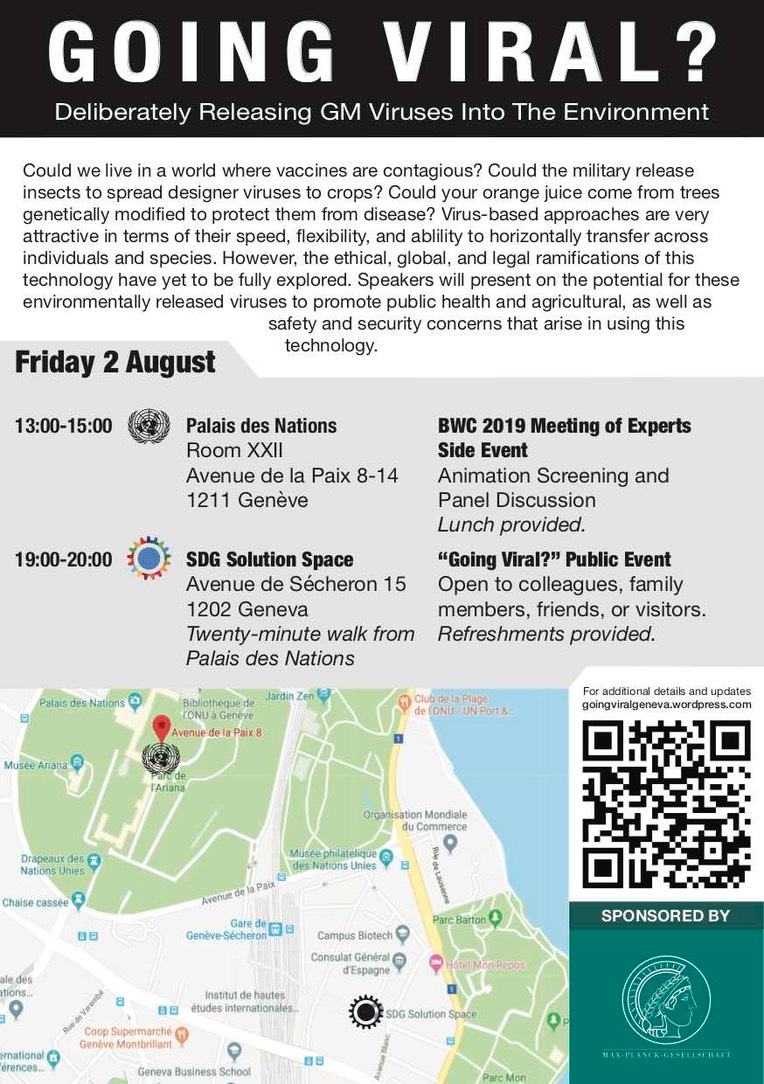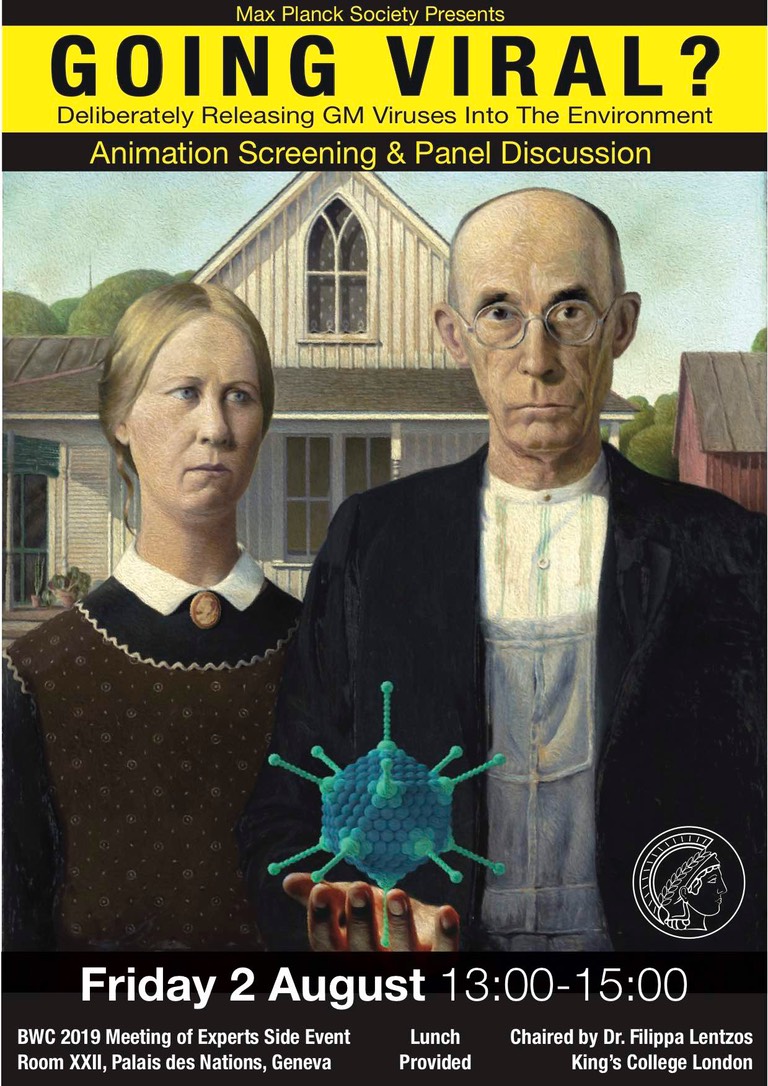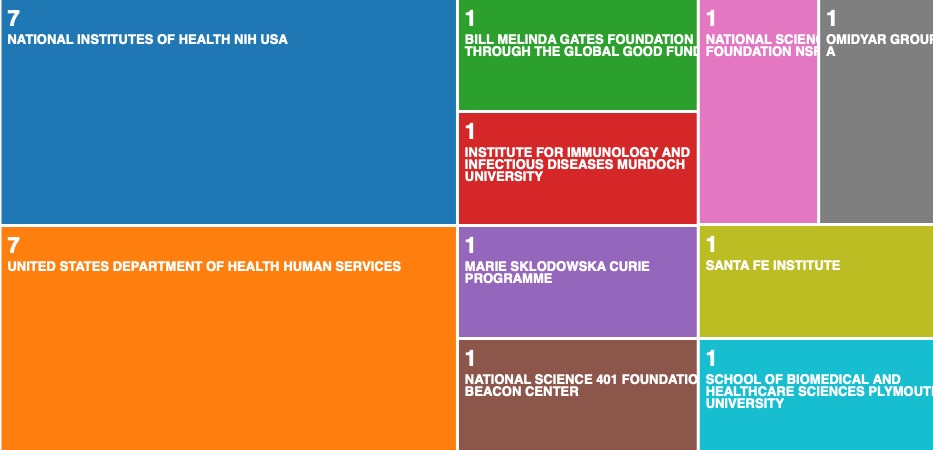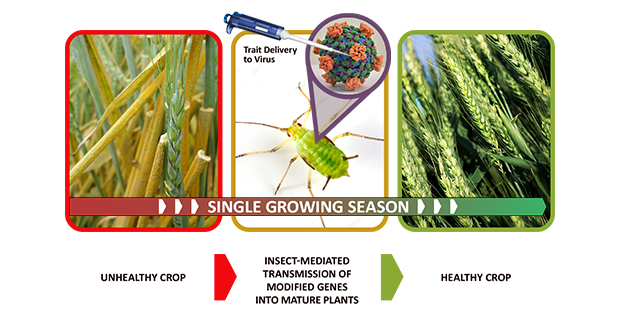This site is intended to accompany the above publication. Without reading this short article you may find that this site will not make a lot of sense.
The purpose of this site is to contribute towards fostering an informed and public debate about this type of technology
After more than a year of Open Access to the original article kindly provided by the journal Science a subscription is now required to access the original article.
As an alternative we provide an unformatted version
summaries available German, Spanish1, Spanish2, French 中文
(not necessarily written by us)
German version of above animation
6th Jan 2022
See our new website which is largely focused on proposals for self-spreading vaccines. This includes open access link to article Eroding norms over release of self-spreading viruses. Science Vol. 375, Issue 6576, pp. 31-33 DOI: 10.1126/science.abj5593 . This work grew from the panel discussion detailed below.
3rd September 2020
Panel discussion as part of 2020 ESOF Going viral? Why Now? Intentional dispersion of GM viruses outside of contained facilities. This session aims to foster discussion on techniques involving the deliberate releases of GM viruses into the environment and the implications of developments that might be anticipated within the next 2-5 years. Perspectives from biological and social scientists, ethicists, and policy experts.
Available to watch online at
Added June 2020:
The first Insect Allies funded scientific publication became available at the beginning of this month.
2020 June. Multiplexed heritable gene editing using RNA viruses and mobile single guide RNAs.
Nature Plants (doi:10.1038/s41477-020-0670-y)
As the title, abstract and body of the article makes clear, heritable changes were made to mature plant chromosomes, mediated by virus encoded CRISPR gRNAs.
This appears to directly contradict numerous statements reportedly made by the DARPA program manger of Insect Allies, for example:-
“All of our teams are actually working with transient expression systems,” meaning that the introduced genetic material does not alter chromosomes or the germ line, and thus would not affect future plant generations."Blake Bextine DARPA Insect Allies program manger.
The Scientist, Abby Olena, 4th October 2018
„He also said that the program is not targeting the germline cells of plants and thus would not lead to heritable traits.“ Blake Bextine DARPA Insect Allies program manger.
Washington post, Joel Achenbach, 4th October 2018
“..Well, so 'modify' is kind of overstating it, we are actually working with viruses that provide transient protection to plants, so it is a protection that does not incorporate into the chromosomes..“ Blake Bextine DARPA Insect Allies program manger.
Elsa Partan & Heather Goldston, Living Lab Radio on WCAI time point 12:32
See more similar quotes listed both here and here.
Added March 2020:
The raised concerns about the Insect Allies programs have recently been presented in a recent Congressional Research service (USA) document entitled Defense Advanced Research Projects Agency: Overview and Issues for Congress, see page 21
Added Jan 2020:
To come up with solutions to some of the issues that face us is essential that a range of relevant perspectives are considered. While, technical, ethical and legal aspects of HEGAAs have been considered, despite is importance a strategic military view has often been lacking, in his thoughtful article Manmohan Bahadur (Centre for Air Power Studies, New Delhi) provides this. The weaponisation of food is taking a new form. It could change warfare
Added 18th Dec 2019:
An author of original Science article,Christophe Boëte
Institut des Sciences de l'Evolution (ISEM), has been awarded a prestigious prize for his continued writing on the topic.
Les inquiétants scénarios de la biologie végétale high-tech aux États-Unis
Added 5th Dec 2019:
A recent video considering the Insect Allies program was aired by the German broadcaster ZDF. It is by Birgit Hermes and colleagues, it is in 6 minutes long and is in German. It was broadcast to coincide with a Biological weapons meeting at the UN.


3 day meeting culminating in a panel discussion at the UN chaired by Filippa Lentzos (Kings College, UK) and a separate public meet at the Geneva SDG solution space, both Entitled: Going viral? Deliberately releasing GM viruses into the environment.
Three topics relating to dispersion of GM viruses into the environment (not within contained facilities) will be covered:-
· Transmissible virus intended to manipulate the immune system of vertebrates (including humans) upon infection.
· Gene editing viruses intended to genetically modify the chromosomes of the individuals they infect (HEGAAs).
· Non-transmissible viruses without capacity for gene editing in agriculture.
We plan to focus on likely developments within the next 2-5 years. Updates on recent discussions elsewhere on the same topics, including the CBD, will be considered. The above video was shown to Diplomats and government advisors.
Added 19th May 2019:
Innovative use of the Insect Allies program as a case study for participants in "Dual use and responsible research:
ethical challenges” at the Karolinska Institute, Stockholm, run by Malcolm Dando and Simon Whitby (Bradford University, UK) in November 2018.
The clip below jumps to a short introduction on anti-crop weapons over the last 70 years by Simon Whitby.
If you advance the above clip to time point 1:14:15 there is a fascinating first impression of a group of participants to the information provided to them about the Insect Allies program.
Added 7th May 2019:
"The speed with which Open Phil has emerged as a significant power-player in international biosecurity policy has, by and large, outrun academic scrutiny of its impacts."
Filippa Lentzos (Kings College, UK) thoughtfully considers how funders priorities might shift risks and unintentionally reduce oversight in key areas. Will splashy philanthropy cause the biosecurity field to focus on the wrong risks?
Added 5th Feb 2019:
The Biological Weapons Convention is a major part of why for over 40 years the development or use of this type of capability has remained rare, as such the convention should be viewed as a success.
However, in the view of Nicolas A. Sims (LSE) the principle ongoing fragility of the Convention stem not from legal or institutional issues, but flows from the failure of States to
This sentiment and its connection to the quote was copied from a chapter by Jez Littlewood (NPSIA) in; Preventing Chemical Weapons. 2018.
The link to the Insect Allies program, which is a topic of this website, is that even as this program approaches is half-way point there has regrettably been no attempt to explain how its claimed agricultural aims could be achieved without a much earlier proliferation of the knowledge necessary to generate a class of targetable biological weapons and their means of delivery (or to point to any farming group who thinks their aims are a good idea).
S
Added 24th January 2019:
In the original Science publication we missed this earlier very interesting paper that includes numerous biosecurity experts as authors:-
The US Defense Advanced Research Projects Agency (DARPA) invested $110 million in synthetic biology in 2014, which accounted for almost 60% of funding for synthetic biology in the US that year, and this figure increases to67% when other Department of Defense funding is included (Kuiken, 2015). The UK Defence Science and Technology Laboratory has also invested in synthetic biology, albeit on a smaller scale, and mainly focussed on developing novel materials (DSTL, 2016). Defense agencies report that they are investing in these programs with a view to preventing or responding to particular threats. However, areas in which some agencies are investing (e.g. agriculture, gene drives, chemical production) could raise both public perception issues and have dual-use potentials. For example, DARPA’s Insect Allies Program intends to use insects to disseminate engineered plant viruses that confer traits to the target plants they feed on (Defense Advanced Research Projects Agency, 2016b), with the aim of protecting crops from potential plant pathogens. However, it is plausible that such technologies could be used by others to harm targets.
Wintle, Bonnie C, Christian R Boehm, Catherine Rhodes, Jennifer C Molloy, Piers Millett, Laura Adam, Rainer Breitling, et al. “A Transatlantic Perspective on 20 Emerging Issues in Biological Engineering.” ELife 6 (November 14, 2017): e30247. https://doi.org/10.7554/eLife.30247.
Added 5th January 2019:
Insect Allies listed by Forbes Magazine by Jessica Baron as one of "ten technologies that people should be aware of in the hopes of giving non-experts a window into what's going on in labs around the world.” Tech Ethics Issues We Should All Be Thinking About In 2019
An article written by Dr Christophe Boëte, one of the authors of the Science article, Les inquiétants scénarios de la biologie végétale high-tech aux États-Unis
Science article mentioned in an interesting way in the last 30 seconds of Guardian long reads podcast written by Bernhard Warner
Added 5th November 2018:
In a Washington Post Editorial on the 4th Nov 2018 it was asserted by the Editorial Board that “The skeptics say on their website that they worry the DARPA program could be “easily weaponized.” That seems a stretch.” .
In response, we repost the text below that has remained part of our FAQ page since 3rd of October in addition to this text. Both elaborate on just one of the scientific reasons why HEGAAs development risks early proliferation of the knowledge required for a targetable bioweapons ( a property that is not shared with most other techniques , including avant-garde ones like gene drive).
Why do we assert that it is almost always easier to develop a HEGAA biological weapon system than an agricultural one ?
- To conceive of a routine use in agriculture for HEGAAs it will be necessary to build in multiple mechanisms to control the spatial and taxonomic spread of the viruses. This will be complicated.
- When developing a biological weapon, most if not all ‘safeguards’ or ‘independent kill switches’ can be left out. Usefully the targeting of gene editing to your enemies crops is assured by the DNA sequence specificity of the 2 guide RNAs used by CRISPR (see Figure in Science paper, it is notable that the specificity of the guide sequences is one of the few elements that the insect allies program relies on which is in any way largely predictable )
- While to kill or sterilise a plant can likely be achieved by disrupting a single suitable gene, more complex traits will probably require inserting new genes or genes into plant chromosomes (examples repeatedly presented include resistance to drought, frost, flooding, salinity, herbicides, and plant disease). In most circumstances it is more than x1000 times more efficient to cause gene disruption than gene insertions (eg Mao, Z., Bozzella, M., Seluanov, A. & Gorbunova, V. Comparison of nonhomologous end joining and homologous recombination in human cells. DNA Repair (Amst.) 7, 1765–1771 (2008) ).
Added 31st October: in recent media comments DARPA appears to be suggesting that gene editing of plant chromosomes by viruses was not a goal of their program from the start (i.e. HEGAAs development). We believe that this is unambiguously not the case- please click here and decide for yourself.
Consider what this publicly funded program is developing
Image credit: www.darpa.mil , reuse in accordance with USA.Gov policy
Genetically modified viruses to perform gene editing of crops in already-planted fields?
Genetically modified viruses intended to be dispersed into the environment using insects?
The DARPA ‘Insect Allies’ program
Some of recent coverage of the issue genetically modified viruses engineered to modify the genome of a second species when released in to the environment (HEGAAs )
‘Insect Allies' Program Draws Criticism
Above is a very interesting and informative radio interview with one of the authors and the DARPA project manager.
Could We Turn Insects Into Biological Weapons?
Crop-protecting insects could be turned into bioweapons, critics warn
Les inquiétants scénarios de la biologie végétale high-tech aux États-Unis
The weaponisation of food is taking a new form. It could change warfare
德法科学家质疑美国军方开发生物武器,违反《禁止生物武器公约》
Alertan que Estados Unidos utiliza insectos como armas biológicas en cultivos
Scientists: Pentagon’s Plant-Virus Research Could Endanger World’s Food Supply
Cientistas alertam que programa militar dos EUA pode ser visto como arma biológica
Ученые заподозрили DARPA в разработке биологического оружия
Gentechnik: Insekten als Viren-Taxi
EUA estão tentando criar insetos como armas biológicas
Was, wenn die Superviren sich gegen uns wenden?
Alertan que Estados Unidos utiliza insectos como armas biológicas en cultivos
Des insectes pour disséminer des virus : une arme incontrôlable ?
Viruses Spread by Insects to Crops Sound Scary. The Military Calls It Food Security.
The Pentagon is studying an insect army to defend crops. Critics fear a bioweapon.
「ついに米軍が“昆虫”を生物兵器に使いそう」学者が告発! 運び屋の虫が病気をバラまき遺伝子強制変換… 影響は未知数!?
Scathing Report Accuses the Pentagon of Developing an Agricultural Bioweapon
The US military is hacking insects with virus DNA, raising fears of dangerous new bio-weapons
DARPA IS MAKING INSECTS THAT CAN DELIVER BIOWEAPONS, SCIENTISTS CLAIM
Questions Raised About DARPA-Funded Crop Program
Kế hoạch đội quân côn trùng của Lầu Năm Góc
Des insectes pour transformer un champ en OGM : l'inquiétant projet de l'armée américaine
US plan to genetically alter crops via insects feared to be biological war plan
Scientists: US military program could be seen as bioweapon
The Pentagon is studying an insect army to defend crops, but critics fear a bioweapon
Scientists: US military program could be seen as bioweapon
Alerta por un programa militar para propagar virus con insectos
An international multi-disciplinary team of lawyers (University Freiburg) and scientists (Max-Planck-Institue in Plön and University Montpellier) argue the Insect Allies program is likely to have immediate impacts on global biosecurity (regardless of whether it proves technically successful or not).
“the program may be widely perceived as an effort to develop biological agents for hostile purposes and their means of delivery, which — if true — would constitute a breach of the Biological Weapons Convention.”
Image credit: Derek Caetano-Anollés
This site provide an extended biological perspective on aspects of our recent Science article.
The description of the 4 year ‘Insect Allies program that commenced in summer 2017 is almost exclusively based on United States Government documents and press releases from the funder (DARPA) and the 3 academic groups doing the research.
(Reading pages 4-12 of the above document provides the best available description of the program we are aware if )
The Insect Allies program is the first to propose or fund the development of HEGAA viruses.
What are HEGAAs-horizontal environmental genetic alteration agents?
- HEGAAs are viruses which have been genetically modified to gain a capacity to edit the chromosomes of a target species (e.g. plant or animal) when intentionally released into the environment
- The word “horizontal” comes from their ability to be transmitted in the environment by infection
- The word “environmental” comes from the intention for these genetically modified viruses to be dispersed into the environment.
- The words “genetic alteration agents” comes from the capacity to alter the chromosomes of a target species. This might be through causing a random mutation or introducing a new DNA sequence.
- The specificity of HEGAAs is dependent on two things (1) the range of species the genetically modified virus can infect AND (2) the presence of the suitable DNA sequences in the plant chromosomes of cells that become infected.
- An example of an insect dispersed viral HEGAA which disrupts a specific plant gene is illustrated in this figure below
Even as the halfway point of the Insect Allies program approaches, DARPA has chosen not to publicly describe in its response to our Science article what is the basis of their having concluded that a developmental pathway exists that circumvents the early proliferation of biological weapons (described by the black development path in the accompanying image). This is in addition to explaining in detail why their developmental plan is easier to develop than alternative paths (described by the red paths). As our Science article makes clear, this is central to justifying the wisdom of embarking on the development of HEGAAs, and many other types of GM viruses.
Over the next five years, only a minority of anticipated CRISPR-inspired innovations will involve intentional environmental releases (see recent NAS report). HEGAAs, and some other GM viruses, have the property of an early-stage biological weapons proliferation risk that is not shared with most other proposed techniques (including avant-garde ones like gene drive).
Choosing not to clearly address these obvious issues of global concern, as detailed in the Science article, makes their current model of develop first and explain later an especially unwise path, particularly for this insect-delivered program, that in many ways appears to be designed to get carried away.
Are HEGAAS the first genetically modified viruses proposed for use in the environment?
No. In fact there have even been at least 4 field trials, probably starting around 1993 (see FAQ page for more details and this .xls file)
Though none of these were HEGAAs, i.e. the viruses do not have any artificially conferred capacity for gene editing
Interest in genetically modified viruses, including HEGAAs, largely stems from their rapid speed of action, as infections can sweep quickly through target populations. This same property is also a serious safety concern, in that it makes it hard to predict where viruses geographically disperse to or what species they eventually infect.
Other authors prior to us have highlighted the pressing need for a trans-national framework to make informed and transparent decisions about genetically modified viruses e.g.
1. Angulo, E.; Gilna, B. When biotech crosses borders– international governance of self-dispersive GMOs purposefully released for public health, controlling invasive species and pests, and treating wildlife. Nature Biotechnology 2008
2. Angulo, E.; Cooke, B. First synthesize new viruses then regulate their release? The case of the wild rabbit. Molecular Ecology 2002,
3. Kuiken, T. DARPA’s Synthetic Biology Initiatives Could Militarize the Environment. Slate 2017.
Probably due to the complex regulatory, biological, economic, and societal implications that need to be considered little progress has been made on how genetically modified viruses should be regulated when the intention is to disperse them in the environment.
It is in this context that DARPA presented its Insect Allies work program in Nov 2016
(reading pages 4-12 provides the very best description of its aims)
What makes the DARPA Insect Allies program unique compared to all earlier GM virus programs?
- It is the very first program to propose or fund the development of HEGAA viruses. These have the capacity to perform genetic engineering in the environment (this might also include seeds if the target species is a plant)
- The insect based means of delivery mandated in the work plan for the genetically modified viruses is obviously unpredictable
- The motivations provided for earlier programs were clear and plausible
- The DARPA program is more easily weaponized than developed into an agricultural system sufficiently controllable to conceive of use in agriculture (this is nothing to do with the fact that DARPA is a military agency) - an earlier text of this clause was modified on the 6th of November
Why do applied uses of viruses require functional trans-national control?
If you take the example of the release of viruses to control rabbit populations (these were not genetically modified viruses), then the number of approved releases of viruses is dwarfed by other kinds of trans-national movements (some of which are inter-continental). If a transmissible virus is perceived to be effective and useful it is in many circumstances reasonable to assume that will be moved without approval.
Information taken from Angulo, E.; Cooke, B. First synthesize new viruses then regulate their release?
The case of the wild rabbit. Molecular Ecology 2002, 11, 2703–2709
Are proposals for the use of GM viruses in the environment likely to remain limited to agriculture?
Probably not. In the absence of functional trans-national frameworks for discussing genetically modified viruses, and HEGAAs specifically, it is conceivable that other applications will also be proposed and funded.
For example, below is the frequency of publications explicitly considering the possibility of developing vaccines which are transmissible between individuals (removing the necessity of individual vaccination, along with any possibility of informed consent).
The 13 above studies cited were funded by the following bodies according to the Web of Science.

awareness of HEGAAs and insect-based means of their delivery is currently very low among nonspecialist scientists and policy-makers, even though it is anticipated that key development milestones should be achieved within the next year. Should this be accepted as the global norm for funding projects that enable such potentially hazardous directions of research, the best practices and rules, which have contributed to keeping our world largely free from the use of devastating biological weapons for over 60 years, may be seriously undermined.
To contact authors of the Science article use the following address or links on press release pages above

Dr. Guy Reeves
Max Planck Institute for Evolutionary Biology, Plön
reeves@evolbio.mpg.de
(media requests by e-mail only)
http://web.evolbio.mpg.de/~reeves/Site/GuyReeves.html
Artwork credit: butterknife, Dylan Egon
